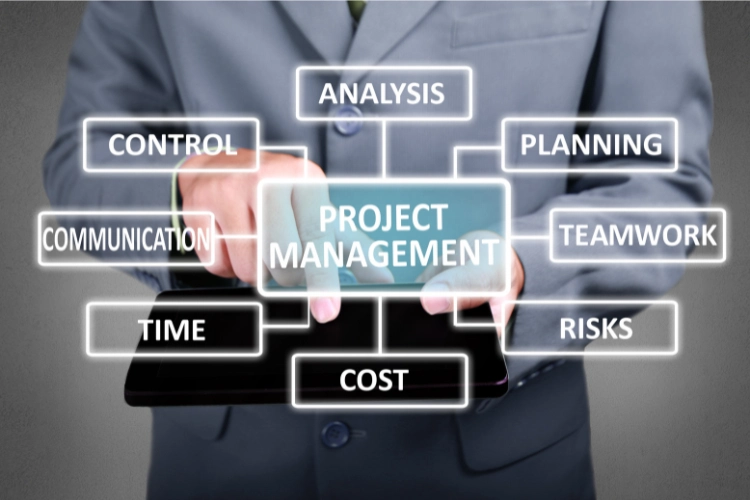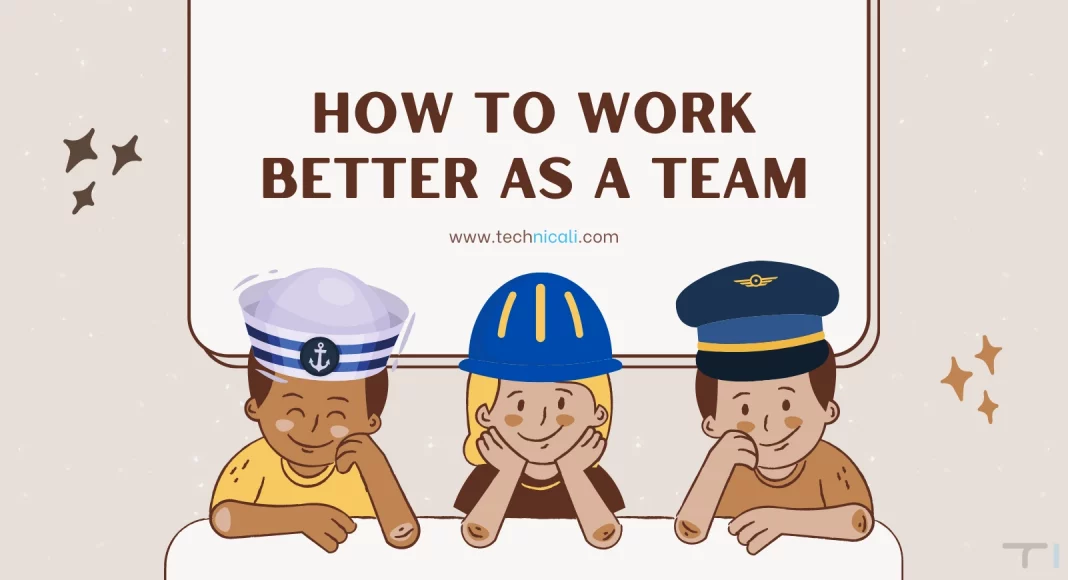Strong teams develop from an individual level. You may boost productivity, effectiveness, and company operations by encouraging cooperation and organising team meetings. Practical cooperation demonstrates openness, trust, and respect among fellow team members.
Learning to work together helps to communicate better, comprehend more, and pay closer attention to the tasks a team member is working on. It is not surprising that team collaboration is intimately related to, if not entirely ingrained in, corporate culture.
The secret is creating the ideal team environment to grow and expand. Think about it– you wouldn’t merely scatter some seeds and tell your plants to sprout if you were attempting to produce a flourishing vegetable patch. You would follow the directions, consider what they require, and provide them with that setting. The same holds for teamwork. You must provide your entire team with the ideal environment for growth.
Contents
How is teamwork essential in the workplace?

Effective teamwork should be crucial to you if keeping your best employees, generating income, and engaging your senior leadership are critical components of your business strategy.
To fully grasp the value of effective teamwork in the workplace, it is necessary that a team player aware of his/her capability should collaborate with fellow team members to develop frequent communication and more deliberate collaborations, resulting in more effective group works. Start with the individual to build strong teams as team dynamics and strengths directly impact company results.
An effective team built on a solid foundation promotes the following:
- Increased motivation
A team player cooperates to achieve team goals and assist one another along the way. Working as a whole team fosters a sense of trust and respect inside the group. Respecting your colleagues motivates you to do well for them, and sometimes they become your best friends in life. A successful team develops a strong sense of understanding, sparks a desire to do well and steers toward clear goals faster.
- Unbiased perspective
Employees in an organisation develop novel methods to tackle problems by working together and learning from one another’s perspectives, therefore utilising innovation to achieve our objectives. Different viewpoints and degrees of expertise help promote accountability and enable your staff to keep one another accountable for their jobs. A further fantastic strategy to keep learning from others is to promote feedback-giving among peers, which various viewpoints encourage.
- Learning opportunities
You get the chance to broaden and deepen your existing expertise by working with the entire team. It doesn’t matter if these lessons come from failures or successes, as there is always something to be learned. Sharing of information within the team is encouraged through teamwork.
- Increased efficiency and productivity
Working together regularly with your team allows you to learn from their perspectives and input on projects and discover new approaches to tasks more quickly and effectively, leading to process improvements.
- Workplace synergy
The essence of successful teamwork is joining together and cooperating to achieve a common objective. When team members take ownership of their work and recognise their role in the current project, synergy can occur. Team members will be motivated to share ideas, same vision, beliefs and set priorities when they are aware of their duties and responsibilities and how much the rest of their team depends on their production. As a result, an atmosphere of collaboration, respect, trust, and creativity is fostered at work.
- Collaboration builds confidence
You may boost productivity, effectiveness, and company operations by encouraging cooperation. Practical cooperation demonstrates coworkers’ openness and respectful communication.
Learning to work together helps in communicating better and paying closer attention to the important job that the other employees are working on. It is not surprising that collaboration is intimately related to, if not entirely ingrained in, corporate culture.
Understanding the problems

Destructive dynamics might hamper collaboration attempts. Everyone has witnessed team members hide facts, pressure others to act a certain way, shirk responsibility, assign blame, etc. By creating explicit norms—rules that outline a small number of actions that members must always do (like attend sessions on time and allow everyone to speak) and a limited number of things, members must never do—teams can lessen the likelihood of dysfunction (such as interrupting). When team members work across various national, regional, or organisational cultures, it is crucial to instil these standards (and may not share the same view of, for example, the importance of punctuality). Additionally, it is essential to reiterate the criteria in teams with flexible membership is essential.
- Team members from different backgrounds interpret a team’s goals differently.
Adding members is a method to ensure a team has the necessary skills and variety, but larger groups have a higher overhead. Greater vulnerability to poor interaction, fragmentation, and social loafing exists in larger teams. Managers regularly complain that teams bloat when additional people are added to improve buy-in from various locations, divisions, or roles and global experts are brought in. Team leads must be careful only to enlist new members when necessary, with a specific limit for the minimal number.
You should create assignments for teams with the same care. Many tasks call for a certain level of struggle; not all of them need to be very imaginative or exciting. However, leaders may increase motivation for any activity by ensuring that the team is in charge of a sizable project from start to finish, that the team members have a great deal of autonomy in managing that project, and that the team obtains performance feedback on it.
- Team problems are due to a resource difference, not a cultural clash.
In 4-D teams, incomplete information is very common and is frequently hampered by digital reliance. Only a handful of them gets to know crucial information that others do not in remote work culture. Participants face-to-face can rely on nonverbal and contextual clues to explain what is happening.
For instance, when we enter a physical meeting, we can immediately perceive the personalities of each person, and the team understands as a whole to shape subsequent encounters. It provides a group with a frame of reference, enables the group to assess situations and make decisions appropriately, aids in greater intergroup understanding, and significantly boosts efficiency. Relying on digital communication makes transmitting this vital form of intelligence harder. The geographical distance between team members creates tension when problems arise.
The role of leaders in teamwork

Managers have a crucial role in promoting workplace teamwork. The manager alone determines 70% of the variability in team engagement. Given that all teamwork-related decisions ultimately rest with the manager, we should say that managers are of utmost importance.
A good leader can improve teamwork by setting clear expectations for the team members. Leaders need to concentrate on two qualities in addition to encouraging their workforce:
- Bring together various teams: Executives want a communicated objective and purpose that everyone can readily connect to their daily job — their contribution.
- Recognising decision-making limitations (strengths and weaknesses), exercising critical thought, and relying on
Excellent leaders define teamwork skills clearly and connect them to performance expectations. The team’s work is better able to meet team goals when they know the bigger picture or the overall mission.
Leaders shouldn’t always assume that staff members know how to achieve their objectives. Even though management and employee jointly define the original goals, priorities and circumstances might change.
The manager must steer the team on the right path while keeping an eye on the environment in which their employees live and work. Managers can view the complete range of work their team produces through regular meetings, prearranged check-ins, and impromptu touch bases.
When it comes to successful teamwork, the supervisor is the one who establishes the standards, points out ways to enhance team communication, and often distributes the burden. This will be successful only when the manager decides to continue being active with and committed to their team.
Sounds like an impossible goal to achieve? Considering your team’s strengths will come in handy in this situation. Each person may have a different definition of or approach to collaboration.
A strong leader may build a strong foundation that supports the weight of all your administrative duties by gathering individual employee opinions about teamwork, including what they need and expect. To assist, create and manage expectations linked to objectives and high performance, discuss your approach and have talks based on your capabilities. This is the manager’s responsibility.
Characteristics of a good team member

Setting priorities, exercising discipline, and following through are crucial skills for becoming a good team member.
- Better Role Understanding: Having a clear idea of your role helps in maintaining alignment with your team members. Before contributing your ideas and solutions, be sure you’re paying attention to others and genuinely considering their advice.
- Effective Communication: Try to choose the communication method that is most appropriate for your particular requirements, whether it be an email, chat program, phone conversation, or in-person meeting. Establish the tone for team communication. Collaboration tools allow employees to have a group or one-on-one discussions with colleagues locally or globally. Additionally, it will enable them to choose projects at times that work best for them.
- Taking Blame: A good team player doesn’t point fingers at others when problems arise. Team members support each other and focus on the solution. A successful team is built when team players deal with difficult tasks and don’t shy to take individual blames.
- Commitment to effective teamwork: A better team player shows his commitment to improving teamwork with critical thinking, support and investing time to help fellow team members. If a team player puts faith in others, it radically brings up team morale.
How to improve teamwork?

You won’t be able to create and implement fresh, creative ideas to their full potential without creating an environment that supports practical cooperation. If team members don’t feel like their fellow members are helping one another reach the goals they have set for the group, achieving the mission and targets will be much more challenging. The efficiency and efficacy of achieving organisational goals are severely hampered in the absence of this support from you and your coworkers.
We must band together if we are to encourage and motivate one another.
- Build trust within the team
Each team member must demonstrate accountability for their tasks to earn the group’s trust. Members that feel trusted are more willing to talk openly, defend their viewpoints, and take the initiative. Team members who trust one another can express their thoughts and emotions while still showing consideration for others.
Spending time with your coworkers outside of the workplace and using this time to get to know each other better is a terrific method to develop trust. You’ll both be able to play to each other’s talents and interests in the job if you talk about your respective hobbies and strengths.
- Create transparency
The foundation of practical cooperation is effective communication—the members of great teams like exchanging ideas, brainstorming, soliciting input, and being refuted. Team members aren’t always in agreement, but they may work past their differences to find a workable solution and keep moving ahead as a unit.
- Give them decision power.
Have each team member decide for themselves. Giving your team decision-making authority is a fantastic way to encourage collaboration. As a manager, you frequently base your decisions on your team’s knowledge. So why not change and give your team more power? It will ensure more freedom and self-assurance to take actions that advance the team’s mission.
- Exercise together
Have occasional exercises together, just like conducting team meetings. These may be quick, easy chores that take less than 10 minutes. It’s crucial to determine the exact issues your team is experiencing before choosing a team-building activity. For instance, does your team need to improve its mutual understanding or heal over a disagreement? For each of these scenarios, you can choose a different workout.
- Have team rules
Rules don’t have to be a drag, but they must be in place to keep everyone on the same page. Rules are everywhere, in daily interactions, as much as on the sports field, and they are there to safeguard everyone and keep them on the same page. How can we go together if we don’t know where we stand? Rules will protect a team’s success and productivity.
It’s great to establish rules early on, but if they’re getting in the way of the team’s success, be open to modifying them. You may either put them in writing or talk about them out loud. In any case, you must be explicit about their purpose and solicit everyone’s input and comments.
- Focus on strengths
Focusing on the team members’ inadequacies might hurt engagement and, as a result, decrease productivity. According to a Gallup study, employees who apply their skills daily are seven times more likely to be interested in their work. Everyone is unique and has various talents, interests, and flaws. Focusing on each person’s talents and assembling a group of people with the necessary skills to complete the task is one of the pillars of a strong team leader. Everyone should be encouraged to contribute by providing a valuable ability to the team, regardless of their weaknesses.
- Accept differences
Nearly all of us have wanted to choke the individual seated next to us at work. I adore this sentence because it perfectly describes the feeling you get when one of your coworkers’ beliefs, demeanour, or working methods catches you off guard. Every company experiences disagreements of opinion at some time; this is only normal.
Opinion differences may cause annoyance, arguments, and occasionally even conflict. However, their many viewpoints and impacts may also benefit a project or finished product. When you don’t handle disagreements properly, issues occur when individuals start to feel ignored, bullied or ignored. Consider having frequent communication if you want to maintain the unity of your team.
Conflicts frequently provide chances for learning. Keep in check that everyone is pleased and that creativity is maximised by handling opposing viewpoints gently and thoughtfully. Your team members should be praised for the abilities they contribute, even though they each have unique qualities.
- Show gratitude
How much appreciation do you express? People are less likely to show thankfulness at work than in any other area, according to a 2,000-person poll. 60% of those individuals said they “either never show thanks at work or do so maybe once a year.”
The realisation that people genuinely want to be acknowledged is quite a shock. If their supervisor showed more gratitude, 81% of those polled said they would work more, and 70% said they would feel better about themselves. It has been demonstrated that gratitude promotes greater feelings of self-worth and trust in the workplace. Being appreciative of both the significant and insignificant contributions that your coworkers make every day can build a strong team.
- Create a sense of commitment
You must take the time to get to know one another to instil a strong feeling of collective commitment in your team. Developing a solid sense of collective responsibility is much simpler when each group member has specific accountability and tasks. Your team can assist and hold each other responsible when everyone knows their colleagues’ efforts. As a result, there will be a more outstanding general commitment to the group’s choices and activities.
- Support your teammates and share information
You possess innate talents and strengths. Give those talents to others without reservation; what will take you five minutes to finish can spare a team player an entire day’s worth of labour and anguish. Helping someone out of a difficult circumstance is the best way to establish trust and a relationship, especially when done voluntarily and without expecting anything in return or owing anybody a favour.
- Celebrate
Celebrations, like acknowledgement and thanks, don’t have to be extravagant but should frequently happen. By doing this, you’re integrating them into your team’s culture, making the advantages more significant and long-lasting. Additionally, you’re reassuring them that your objectives are worthwhile and attainable, which will maintain their drive.
How to recognise bad team members?

Effective workplace communication is essential for achieving outcomes and fostering a good work environment. However, poor communication can destabilise a company and harm the workforce. Recognising unhealthy communication patterns and swapping them out for more effective ones can increase productivity and financial success.
Follow these steps to recognise bad team members effectively:
- Cannot take criticism
Ethics and accountability are two other areas where inadequate communication occurs. A lack of responsibility is demonstrated by a refusal to acknowledge a mistake or take accountability for a missed deadline. Blaming others is ineffective and does not lead to a solution for the greater good. One constructive answer is learning to take ownership of your actions and move on. However, people who continue to hold others accountable for their errors may sour professional relationships and risk being shunned.
- Arrogant
Poor communication techniques like passive aggression directly impact how individuals feel regarding themselves and others in the workplace. Because destructive behaviours are frequently nuanced and may not be perceived as openly violent, disrespectful, or aggressive, passive-aggressive conduct or conversation is a challenging issue. However, the connection is harmed when the individual receiving the communication feels disregarded or mistreated regularly.
- Stubborn
Not listening to coworkers is also a concern in an office setting. It fosters a culture of indifference to human sentiments and devalues workplace interpersonal ties. For instance, if workers raise concerns about a situation they observe at work, and the manager doesn’t investigate the case or ask them for further information, the issue may not be addressed. The workers may feel as though their opinions don’t count. Employees want to know that their contributions to the business purpose are valued and recognised.
- Irresponsible
Employee irresponsibility directly affects efficiency as well as the bottom line. Employee morale can also be harmed if they ignore their duties and rely on other employees to pick up the slack. Just one careless worker may spread a culture of carelessness inside a small corporation, especially if other employees witness the conduct being tolerated or encouraged with promotions or desirable tasks.
- Jealous
When a coworker is concerned or apprehensive about the abilities of another worker, it can lead to envy in the workplace. To avoid and minimise workplace envy between team members, having a good, considerate, and professional attitude is critical. To deal with it effectively, you must first comprehend where and what is producing workplace envy.
Conclusion
Although it has never been simple, teamwork has grown significantly more difficult recently.
As teams become more global, virtual, and project-driven, the factors that make it harder look sure to persist. Analysing your team’s readiness for success can be highly beneficial and pinpoint areas that require development using a systematic approach.

Most team difficulties may be resolved by colleagues being honest with each other and having polite, open face-to-face talks if there is one underlying theme that runs through most of the topics discussed in this guide.

